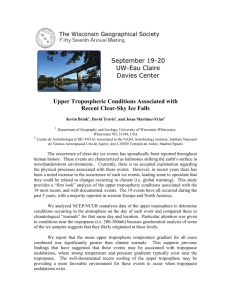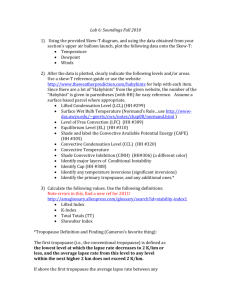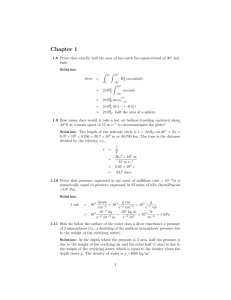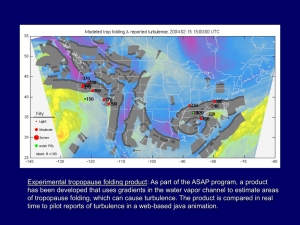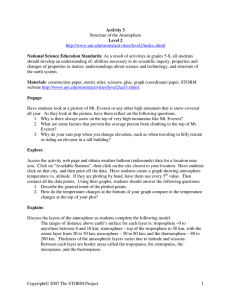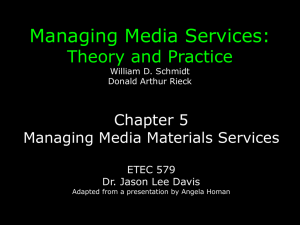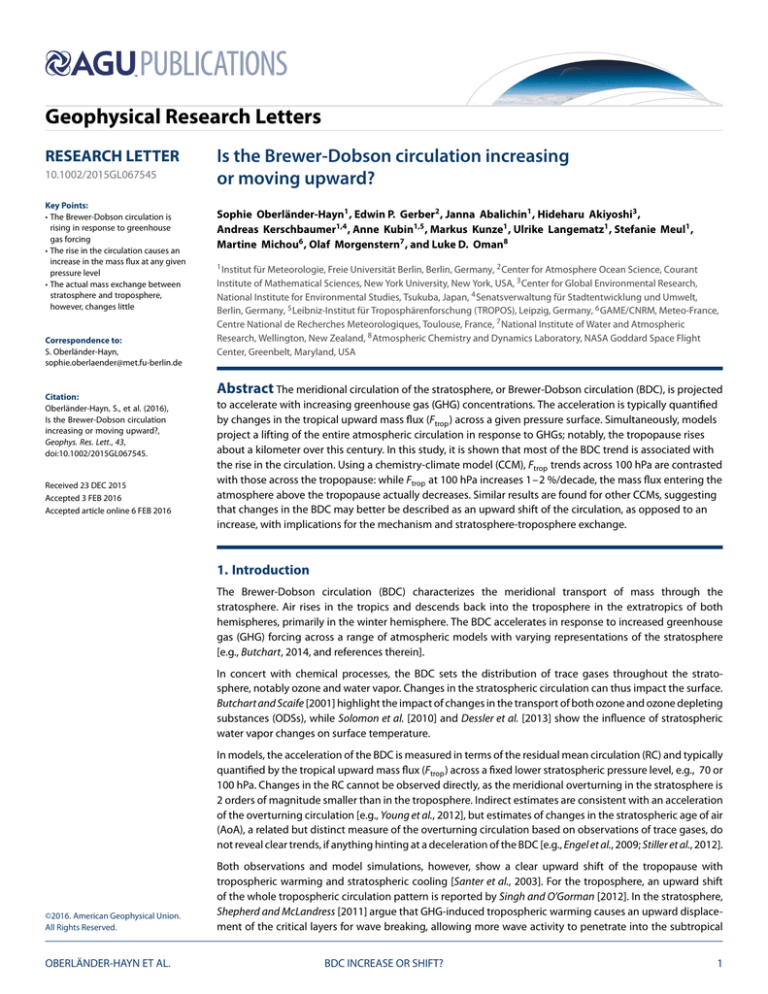
Geophysical Research Letters
RESEARCH LETTER
10.1002/2015GL067545
Key Points:
• The Brewer-Dobson circulation is
rising in response to greenhouse
gas forcing
• The rise in the circulation causes an
increase in the mass flux at any given
pressure level
• The actual mass exchange between
stratosphere and troposphere,
however, changes little
Correspondence to:
S. Oberländer-Hayn,
sophie.oberlaender@met.fu-berlin.de
Citation:
Oberländer-Hayn, S., et al. (2016),
Is the Brewer-Dobson circulation
increasing or moving upward?,
Geophys. Res. Lett., 43,
doi:10.1002/2015GL067545.
Received 23 DEC 2015
Accepted 3 FEB 2016
Accepted article online 6 FEB 2016
Is the Brewer-Dobson circulation increasing
or moving upward?
Sophie Oberländer-Hayn1 , Edwin P. Gerber2 , Janna Abalichin1 , Hideharu Akiyoshi3 ,
Andreas Kerschbaumer1,4 , Anne Kubin1,5 , Markus Kunze1 , Ulrike Langematz1 , Stefanie Meul1 ,
Martine Michou6 , Olaf Morgenstern7 , and Luke D. Oman8
1 Institut für Meteorologie, Freie Universität Berlin, Berlin, Germany, 2 Center for Atmosphere Ocean Science, Courant
Institute of Mathematical Sciences, New York University, New York, USA, 3 Center for Global Environmental Research,
National Institute for Environmental Studies, Tsukuba, Japan, 4 Senatsverwaltung für Stadtentwicklung und Umwelt,
Berlin, Germany, 5 Leibniz-Institut für Troposphärenforschung (TROPOS), Leipzig, Germany, 6 GAME/CNRM, Meteo-France,
Centre National de Recherches Meteorologiques, Toulouse, France, 7 National Institute of Water and Atmospheric
Research, Wellington, New Zealand, 8 Atmospheric Chemistry and Dynamics Laboratory, NASA Goddard Space Flight
Center, Greenbelt, Maryland, USA
Abstract The meridional circulation of the stratosphere, or Brewer-Dobson circulation (BDC), is projected
to accelerate with increasing greenhouse gas (GHG) concentrations. The acceleration is typically quantified
by changes in the tropical upward mass flux (Ftrop ) across a given pressure surface. Simultaneously, models
project a lifting of the entire atmospheric circulation in response to GHGs; notably, the tropopause rises
about a kilometer over this century. In this study, it is shown that most of the BDC trend is associated with
the rise in the circulation. Using a chemistry-climate model (CCM), Ftrop trends across 100 hPa are contrasted
with those across the tropopause: while Ftrop at 100 hPa increases 1–2 %/decade, the mass flux entering the
atmosphere above the tropopause actually decreases. Similar results are found for other CCMs, suggesting
that changes in the BDC may better be described as an upward shift of the circulation, as opposed to an
increase, with implications for the mechanism and stratosphere-troposphere exchange.
1. Introduction
The Brewer-Dobson circulation (BDC) characterizes the meridional transport of mass through the
stratosphere. Air rises in the tropics and descends back into the troposphere in the extratropics of both
hemispheres, primarily in the winter hemisphere. The BDC accelerates in response to increased greenhouse
gas (GHG) forcing across a range of atmospheric models with varying representations of the stratosphere
[e.g., Butchart, 2014, and references therein].
In concert with chemical processes, the BDC sets the distribution of trace gases throughout the stratosphere, notably ozone and water vapor. Changes in the stratospheric circulation can thus impact the surface.
Butchart and Scaife [2001] highlight the impact of changes in the transport of both ozone and ozone depleting
substances (ODSs), while Solomon et al. [2010] and Dessler et al. [2013] show the influence of stratospheric
water vapor changes on surface temperature.
In models, the acceleration of the BDC is measured in terms of the residual mean circulation (RC) and typically
quantified by the tropical upward mass flux (Ftrop ) across a fixed lower stratospheric pressure level, e.g., 70 or
100 hPa. Changes in the RC cannot be observed directly, as the meridional overturning in the stratosphere is
2 orders of magnitude smaller than in the troposphere. Indirect estimates are consistent with an acceleration
of the overturning circulation [e.g., Young et al., 2012], but estimates of changes in the stratospheric age of air
(AoA), a related but distinct measure of the overturning circulation based on observations of trace gases, do
not reveal clear trends, if anything hinting at a deceleration of the BDC [e.g., Engel et al., 2009; Stiller et al., 2012].
©2016. American Geophysical Union.
All Rights Reserved.
OBERLÄNDER-HAYN ET AL.
Both observations and model simulations, however, show a clear upward shift of the tropopause with
tropospheric warming and stratospheric cooling [Santer et al., 2003]. For the troposphere, an upward shift
of the whole tropospheric circulation pattern is reported by Singh and O’Gorman [2012]. In the stratosphere,
Shepherd and McLandress [2011] argue that GHG-induced tropospheric warming causes an upward displacement of the critical layers for wave breaking, allowing more wave activity to penetrate into the subtropical
BDC INCREASE OR SHIFT?
1
Geophysical Research Letters
10.1002/2015GL067545
lower stratosphere, thereby increasing—and lifting—the BDC. The strength of the meridional overturning
decays markedly in height, so that a rise in the circulation will have a pronounced impact on the meridional
overturning when measured at a fixed pressure level, even if the structure remains otherwise unchanged.
In this paper, we use the state-of-the-art chemistry-climate model (CCM) European Centre Hamburg
(ECHAM)/Modular Earth Submodel System (MESSy) Atmospheric Chemistry (EMAC) to separate trends in the
circulation associated with the lifting of the atmospheric circulation from other changes in the mass exchange
between the troposphere and the stratosphere. We find that changes at a fixed pressure level are dominated
by the lifting, and that mass transport in and out of the stratosphere changes comparatively little. A similar
picture emerges from other models participating in the Chemistry-Climate Model Initiative (CCMI) [Hegglin
and Lamarque, 2015], suggesting that changes in the BDC might better be described as a lifting of the overturning circulation than a structural increase in it. This provides a new perspective on the Shepherd and
McLandress [2011] mechanism for the “increase” of the BDC and suggests that changes in stratospheretroposphere exchange, which are important for tracer distributions and AoA based estimates, may be more
subtle than the large changes in the RC measured at fixed pressure levels.
2. Models and Simulations
EMAC is a numerical chemistry and climate simulation system [Jöckel et al., 2006], using the first version of
the Modular Earth Submodel System to link multi-institutional codes, including homogeneous and heterogeneous chemical reactions (Module Efficiently Calculating the Chemistry of the Atmosphere, [Sander et al.,
2005]). The core atmospheric model is the fifth generation European Centre Hamburg (ECHAM5) general
circulation model [Roeckner et al., 2006]. We applied EMAC in the T42L39MA resolution, i.e., with a spherical truncation of T42 (corresponding to a grid of approximately 2.8∘ × 2.8∘ ) with 39 hybrid pressure levels
up to 0.01 hPa. The vertical spacing was chosen to carefully resolve the tropopause region, with levels at
approximately 200, 170, 150, 130, 115, 100, 90, and 80 hPa.
Three atmosphere-only simulations were integrated for 141 years from 1960 to 2100, after at least 5 years
of spin-up. The boundary conditions for the GHGs follow the Representative Concentration Pathway (RCP)
scenarios 4.5, 6.0, and 8.5 [van Vuuren et al., 2011], and the simulations are named RCP4.5, RCP6.0, and RCP8.5,
accordingly. The specifications for the ODSs follow the scenario A1 from World Meteorological Organization
(WMO) [2007]. Sea surface temperatures (SSTs) and sea ice concentrations (SICs) have been prescribed from
scenario simulations performed with the Max Planck Institute Earth System Model (MPI-ESM) [Schmidt et al.,
2013] for the simulations RCP4.5 and RCP8.5 and from the Met Office Hadley Centre Earth System Model
(HadGEM2-ES) [Jones et al., 2011] for the simulation RCP6.0.
A fully coupled simulation, denoted RCP6.0-O, was integrated with the coupled atmosphere-ocean (AO) CCM
EMAC-O, which comprises the EMAC model as described above coupled, via the Ocean Atmosphere Sea Ice
Soil coupler [Valcke et al., 2003], to the ocean model MPI-OM. This simulation has been performed from 1960
to 2096. The GHG and ODS specifications are the same as for the RCP6.0 integration. The analysis of output
from four additional CCMI models, detailed in Table 1, is included for comparison.
3. Tropical Upward Mass Flux With Respect to the Tropopause
The total tropical upward mass flux, Ftrop , is computed by integrating the RC across the region of upwelling
in the tropics. It is commonly used as an indicator for the strength of the BDC [e.g., Holton, 1990], and BDC
changes are typically quantified by changes in Ftrop across a fixed pressure level. Modeling studies almost
universally project an increase in Ftrop across pressure surfaces throughout the stratosphere with rising GHGs
[e.g., Butchart and Scaife, 2001; Li et al., 2008; McLandress and Shepherd, 2009; Butchart et al., 2010; Okamoto
et al., 2011; Oberländer et al., 2013; Bunzel and Schmidt, 2013].
Figure 1a shows the annual mean evolution of Ftrop at 100 hPa from the EMAC simulations and ERA-Interim
reanalysis data [Dee et al., 2011]. We choose the 100 hPa level as it closely matches the tropical tropopause.
For 1979–2013 all EMAC simulations correspond reasonably well with ERA-Interim data. While there is significant interannual variability in the mass flux, the well-established increase in Ftrop in response to enhanced
GHG forcing is projected in all simulations, the increase varying from 0.9 to 1.9 %/decade depending on the
scenario. The strongest GHG scenario simulation (RCP8.5, red) and RCP6.0-O (green) show the largest
OBERLÄNDER-HAYN ET AL.
BDC INCREASE OR SHIFT?
2
Geophysical Research Letters
10.1002/2015GL067545
Table 1. Models and Model Simulations Used in This Studya
Model
Reference
Chemistry
Ocean-SSTs/SICs
Simulations
EMAC
Jöckel et al. [2006]
Interactive chemistry
Prescribed from HadGEM2-ES (RCP6.0)
REF-C2 (RCP6.0),
in T + S
and MPI-ESM (RCP4.5 and RCP8.5)
RCP4.5, RCP8.5
EMAC-O
Jöckel et al. [2006],
Interactive chemistry
Coupled ocean model
REF-C2 (RCP6.0-O)
Jungclaus et al. [2006], and
in T + S
(MPI-OM)
Interactive chemistry
Prescribed from MIROC3.2
REF-C2
Valcke et al. [2003]
CCSRNIES-
Imai et al. [2013]
MIROC3.2
in S
CNRM-CCM
Michou et al. [2011]
Interactive chemistry
Prescribed SSTs
REF-C2
GEOS-CCM
Oman and Douglass [2014]
Interactive chemistry
Prescribed from Community Earth
Two realizations of REF-C2,
in S
System Model version 1 (CESM1)
ODSs: A1 2010 & A1 2014
Interactive chemistry
Coupled ocean model
REF-C2
Niwa-UKCA
Morgenstern et al. [2013]
a All REF-C2 simulations [Eyring et al., 2013] are based on the RCP6.0 scenario [van Vuuren et al., 2011]. The simulations are performed with either stratospheric
(S) or tropospheric and stratospheric (T + S) chemistry included. The sea surface temperatures (SSTs) and sea ice concentrations (SICs) are previously generated
from a coupled AO-GCM and prescribed to the CCM (EMAC, CCSRNIES-MIROC3.2, CNRM-CCM, and GEOS-CCM) or interactively generated by the coupled AO-CCM
(EMAC-O and Niwa-UKCA).
increases. Enhanced warming in the tropics in the coupled simulation RCP6.0-O causes more acceleration
compared to the atmosphere-only simulation RCP6.0 (not shown).
The tropopause is expected to rise in response to GHG-induced warming of the troposphere and cooling
of the stratosphere [Held, 1982; Santer et al., 2003]. As shown in Figure 1c, all EMAC simulations project a
substantial increase in the tropopause height, where the tropopause is identified using the standard lapse
Figure 1. Time series of EMAC simulations RCP4.5 (black), RCP6.0 (blue), RCP6.0-O (green), and RCP8.5 (red) from 1960
to 2100 (1960–2096 for RCP6.0-O) and ERA-Interim data (grey) from 1979 to 2013 in the annual mean for (a) tropical
upward mass flux at 100 hPa (108 kg s−1 ), (b) tropical upward mass flux at tropopause level (108 kg s−1 ), and
(c) tropopause height at the equator (km).
OBERLÄNDER-HAYN ET AL.
BDC INCREASE OR SHIFT?
3
Geophysical Research Letters
10.1002/2015GL067545
Figure 2. Annual mean linear trend in residual mean mass stream function (Ψ∗ ) between 1960 and 2096 for the simulation RCP6.0-O with respect to (left)
pressure levels and to the (right) tropopause. Colored shading indicates statistical significance at the 95% level. The contours are (± 0.05, 0.1, 0.15, 0.2, 0.4, 0.8,
1.0) × 109 kg s−1 /decade with solid lines indicating positive values (zero line in grey), and dashed lines negative values. The annual mean tropopause and the
100 hPa height for 1960 are included in dashed red and grey lines, respectively.
rate definition [WMO, 1957; Reichler et al., 2003]. Given these large changes in the vertical structure of the
atmosphere, we ask whether the change in Ftrop at a fixed pressure level accurately describes changes in
the transport of mass between the troposphere and the stratosphere. Figure 1b shows the time evolution of
the tropical upward mass flux with respect to the tropopause for the EMAC simulations and ERA-Interim
reanalysis. This is computed by integrating the mass flux exactly at the tropopause, adjusting the height
as it rises in response to GHG increase. Between 1960–2000 and 2060–2100 (2096 for RCP6.0-O), Ftrop
at the tropopause actually decreases, with trends of −0.46 ± 0.33, −0.20 ± 0.16 (−0.47 ± 0.30), and
−0.26 ± 0.02 %/decade for the RCP4.5, RCP6.0 (RCP6.0-O), and RCP8.5 integrations.
To show the structure of the RC changes, Figure 2 illustrates the linear trend in the residual mean mass
stream function, Ψ∗ , for the coupled EMAC integration RCP6.0-O; a qualitatively similar picture emerges from
the atmosphere-only integrations (not shown). The trend is computed in two ways, first with respect to
pressure—as is the standard practice—and second, with respect to the tropopause. As in the calculations
shown in Figure 1b, this is achieved by computing the tropopause at each time step, remapping the vertical
coordinate relative to this level (denoted “0” in the plot) and then averaging. A similar procedure was applied
by Birner [2006] to reveal the tropopause inversion layer, which is blurred out when averaged on pressure
levels. More importantly for us, this procedure will also follow the tropopause upward as the atmospheric
circulation responds to GHGs.
The Ψ∗ trend exhibits a strikingly different structure depending on the averaging. When averaged on pressure
surfaces (Figure 2a) the positive (clockwise) anomaly in the Northern Hemisphere and negative (counterclockwise) anomaly in the Southern Hemisphere indicate an acceleration of the circulation. When averaged
with respect to the tropopause (Figure 2b), however, the Ψ∗ trend reveals weak anomalies of opposite sign,
characterizing a modest reduction in the RC at the tropopause in both hemispheres. From a physical point
of view, when mapped relative to a fixed pressure level, changes are dominated by the upward expansion of the Hadley cell, which enhances the circulation in the tropics. But when mapped relative to the
tropopause—which rises with the expanding Hadley cell—there are no significant changes in the tropics at
all, and only a weak reduction in the extratropics.
4. The Effective Shift of the Measurement Level
The ascent of the atmospheric circulation in response to global warming implies that observations held at
a fixed pressure level will effectively “see” a lower part of the atmosphere with time. For example, in the
RCP6.0-O integration, the tropical tropopause shifts from 94.5 to 85.9 hPa from the last decade of the 20th
century to the end of the 21st century. Thus, an analysis at 90 hPa would reveal significant changes in the
chemistry and circulation related to the transition from the stratosphere to the troposphere.
OBERLÄNDER-HAYN ET AL.
BDC INCREASE OR SHIFT?
4
Geophysical Research Letters
10.1002/2015GL067545
Figure 3. Annual mean change in tropical upward mass flux at 100 hPa of EMAC simulations RCP4.5 (black), RCP6.0
(blue), RCP6.0-O (green), and RCP8.5 (red) from 1960 to 2100 (1960–2096 for RCP6.0-O) and ERA-Interim data (grey)
from 1979 to 2013 compared to the mean of the years 1960–2000 (ERA-Interim: 1979–2000) (%) for (a) total change
(Δ Ftrop ), (b) change from shift of the tropopause (Δ Fshift ), and (c) structural change (Δ Fstruct ) from Figures 3a and 3b.
Our goal is to separate the change in the tropical upward mass flux associated with the lifting of the circulation
from other structural changes. The change in Ftrop at a given pressure level, Δ Ftrop , is decomposed into a
change associated with the rise of the circulation, Δ Fshift , and other changes, Δ Fstruct :
Δ Ftrop = Δ Fshift + Δ Fstruct .
(1)
The change associated with an upward shift is estimated with a single term Taylor expansion, using the
|
𝜕F
climatological vertical gradient of the mass flux from the historical period, 𝜕ztrop || , and the shift of the
|past
measurement level relative to the circulation between the future and past climates, Δz:
Δ Fshift =
𝜕Ftrop ||
× Δz.
|
𝜕z ||past
(2)
Note that both terms on the right-hand side of (2) will be negative: the mass circulation decays with height
and a fixed pressure level will sink relative to the tropopause with time. We use the historical simulation to
define the mass flux gradient in an effort to capture future circulation changes given only the trend in the
tropopause. Lastly, Δ Fstruct is defined as the difference between Δ Ftrop and Δ Fshift .
Focussing on a specific lower stratospheric level, here 100 hPa, we estimate the vertical gradient in the mass
flux with the closest levels above and below in the standard CCMI output over the period 1960–2000:
Ftrop (115 hPa) − Ftrop (90 hPa)
𝜕Ftrop |
|
.
=
𝜕z ||past
z(115 hPa) − z(90 hPa)
OBERLÄNDER-HAYN ET AL.
BDC INCREASE OR SHIFT?
(3)
5
Geophysical Research Letters
10.1002/2015GL067545
Figure 4. Climatology and changes in annual mean tropical upward mass flux at 100 hPa for the simulations under the
RCP6.0 scenario from Table 1. (a) Annual mean Ftrop averaged for the period 1960 to 2000 (CNRM-CCM: 1961 to 2000)
(108 kg s−1 ). For comparison climatological data as mean for the period 1979 to 2000 is added from ERA-Interim.
(b) Changes in Ftrop (white), Fshift (green), and Fstruct (blue) between the periods 2060–2100 (2060–2096 for RCP6.0-O
and 2060–2099 for CNRM-CCM and GEOS-CCM) and 1960–2000 (1961–2000 for CNRM-CCM) (%/decade). The red bars
denote the uncertainties at the 95% confidence level. Note that coarser vertical resolution was available for the GEOS
integrations, such that the decomposition likely suffers from larger truncation errors which are not accounted for in the
uncertainty intervals.
We use the tropopause to quantify the shift of the circulation, so Δz is given by the change in the 100 hPa
level relative to the tropopause:
) (
)
(
Δz = z(100 hPa)|future − z(tropo)|future − z(100 hPa)|past − z(tropo)|past
) (
)
(
= z(tropo)|past − z(tropo)|future + z(100 hPa)|future − z(100 hPa)|past ,
(4)
with z(tropo)|future and z(tropo)|past referring to the tropopause height at the future and historical states.
From the first term in (4), we see that Δz will be negative: as the tropopause rises, our effective measurement
level is pushed lower in the atmosphere. The second term corrects for the fact that all pressure levels rise
with tropospheric warming; it will always be smaller in magnitude than the first term if the pressure of the
tropopause drops.
Figure 3a shows the relative change in Ftrop at 100 hPa from EMAC as a function of time. As shown in previous studies, the RC increases substantially in response to GHG forcing. Figure 3b, however, shows that this
increase can almost entirely be attributed to the effective change in the measurement level. It was obtained
using equation (2), where the time evolution comes only from the shift in the 100 hPa surface relative to the
tropopause, Δz.
Δ Fstruct can be interpreted as an estimate of the change in the RC at the tropopause. Consistent with the
analysis in the previous section, the residual “structural changes” in the mass flux, Figure 3c, are small and
(if anything) negative. Notably, the structural term differs less between the different RCP scenarios, i.e., the
impact of enhanced GHG forcing is felt through the rise in the circulation.
Figure 4 places EMAC in the context of other CCMI models. There is substantial spread in the climatological RC;
Ftrop at 100 hPa ranges from ∼70 to 180 ×108 kg s−1 (Figure 4a). All the models, however, project an increase in
Ftrop at 100 hPa under the RCP6.0 scenario forcing. When scaled relative to the climatological mass flux, most
models are clustering around a rate of ∼1%/decade (Figure 4b, white bars).
The green bars in Figure 4b show the change associated with the rise in the circulation: in all cases, the increasing Ftrop trend at 100 hPa can largely be attributed to the rise of the tropopause relative to this pressure level.
With the exception of CNRM-CCM, the shift term ΔFshift is larger than the total change ΔFtrop , suggesting a
weak reduction of the mass transport across the tropopause (Figure 4b, blue bars). In general, differences
OBERLÄNDER-HAYN ET AL.
BDC INCREASE OR SHIFT?
6
Geophysical Research Letters
10.1002/2015GL067545
between the models are comparable to the differences between the atmosphere-only and coupled EMAC
integrations. These EMAC integrations differ at the lower boundary, suggesting that uncertainty in SSTs might
explain the difference between models.
5. Discussion and Conclusions
A wide range of atmospheric and climate models robustly projected substantial changes in the BDC, almost
uniformly quantifying trends by changes in the RC at fixed pressure levels. Our results are consistent with
these previous studies but suggest a new interpretation. Given the lifting of the entire atmospheric circulation in response to GHG increase [Singh and O’Gorman, 2012], the stratosphere itself is changing substantially.
When changes in tropopause height are taken into account, we find that the residual mean transport of mass
between the troposphere and the stratosphere changes little in response to anthropogenic forcing, if anything decreasing slightly. Trends in the RC at a given pressure level can thus be simply linked to the effective
descent of the pressure surface relative to the climatological overturning circulation.
This interpretation of the RC provides a new perspective on the mechanism. Shepherd and McLandress [2011]
explain the RC change as a response to the upward movement of the zero wind line—a critical level for wave
breaking of stationary waves—associated with the lifting of the subtropical jets. The conceptual model of
Held [1982] predicts a vertical extension of the troposphere (and hence of the subtropical jets) in response to
enhanced surface temperatures. Essentially, as the surface warms, the tropopause must rise in order to keep
the atmosphere in radiative balance. Santer et al. [2003] demonstrate that a rising tropopause is a generic
response of the atmosphere to changing GHGs. Our analysis suggests that an increase in the RC at a given
pressure surface in the lower stratosphere may be equally generic. While models differ substantially in their
ability to capture the meridional overturning of the stratosphere (e.g., Figure 4a), equation (2) implies that
the relative change in Ftrop depends largely on the shift of the tropopause. The CCMI models examined in
this study predict a similar increase in tropopause height and thus a fairly uniform relative increase in the RC
(Figure 4b).
We have focussed on the 100 hPa surface, given its proximity to the tropopause, but our approach can equally
be applied to other surfaces. For example, the 70 hPa surface is often used as a benchmark for the strength
of the RC. The EMAC-O integration projects an increase of 1.24 ± 0.60 %/decade at this level, consistent with
other models [e.g., Butchart et al., 2010]. In the twentieth century climatology of EMAC, 70 hPa is 1.71 km above
the tropopause, but by the end of the century, it is only 1.16 km above the tropopause. This shift causes an
Ftrop increase of 1.29 ± 0.80 %/decade at 70 hPa.
Acknowledgments
This work was supported by the DFG
Research Unit FOR 1095 (SHARP)
grants LA1025/13-2, LA1025/14-2,
and LA1025/15-2, the DFG project
ISOLAA (LA 1025/19-1), the BMBF
MiKlip project (01LP1168A), the
project StratoClim (603557), and the
U.S. NSF (AGS-1264195). We thank
the North-German Supercomputing
Alliance (HLRN) and ECMWF
computing center, the modeling
groups, and the WCRP SPARC/IGAC
CCMI for organizing and coordinating
the model activity. O.M. acknowledges
funding by the Royal Society
Marsden Fund and by NIWA under its
Government-funded, core research.
NIES’ research was supported by
the Environment Research and
Technology Development Fund
(2-1303) of the Ministry of the
Environment, Japan. Data for this
paper are available at the Freie
Universität Berlin SHARP data
archive under GRL_BDC_increase_
or_shift_Oberlaender-Hayn_2015.tar.
OBERLÄNDER-HAYN ET AL.
While mass exchange between the stratosphere and the troposphere remains about constant in models, the
ventilation of the stratosphere will change. The 10 hPa shift in the tropopause simulated by EMAC implies an
approximately 10% reduction of the mass of the stratosphere. Neglecting the mixing of air along isentropic
surfaces which cross the tropopause, the transit time of air through the stratosphere is given by its total mass,
M, divided by the total mass exchange rate, Ftrop . Hence, if the exchange rate remains about constant while M
decreases, the mean transit time will decrease. Barring substantial changes in isentropic mixing, one would
then expect the AoA to decrease. Based on an analysis of CCMs, Garny et al. [2014] suggest that the isentropic
mixing may actually change predictably with the circulation and further reduce the AoA. Thus, our results
do not resolve the mismatch of modeling studies with observational studies that find little evidence for a
decrease in the AoA to date [Engel et al., 2009; Stiller et al., 2012].
References
Birner, T. (2006), Fine-scale structure of the extratropical tropopause region, J. Geophys. Res., 111, D04104, doi:10.1029/2005JD006301.
Bunzel, F., and H. Schmidt (2013), The Brewer-Dobson circulation in a changing climate: Impact of the model configuration, J. Atmos. Sci.,
70, 1437–1455.
Butchart, N. (2014), The Brewer-Dobson circulation, Rev. Geophys., 52, 157–184, doi:10.1002/2013RG000448.
Butchart, N., and A. A. Scaife (2001), Removal of chlorofluorocarbons by increased mass exchange between the stratosphere and
troposphere in a changing climate, Nature, 410, 799–802.
Butchart, N., et al. (2010), Chemistry-climate model simulations of twenty-first century stratospheric climate and circulation changes,
J. Clim., 23, 5349–5374, doi:10.1175/2010JCLI3404.1.
Dee, D. P., et al. (2011), The ERA-Interim reanalysis: Configuration and performance of the data assimilation system, Q. J. R. Meteorol. Soc.,
137, 553–597, doi:10.1002/qj.828.
Dessler, A. E., M. R. Schoeberl, T. Wang, S. M. Davis, and K. H. Rosenlof (2013), Stratospheric water vapor feedback, Proc. Natl. Acad. Sci., 110,
18087–18091, doi:10.1073/pnas.1310344110.
BDC INCREASE OR SHIFT?
7
Geophysical Research Letters
10.1002/2015GL067545
Engel, A., et al. (2009), Age of stratospheric air unchanged within uncertainties over the past 30 years, Nat. Geosci., 2, 28–31,
doi:10.1038/ngeo388.
Eyring, V., et al. (2013), Overview of IGAC/SPARC Chemistry-Climate Model Initiative (CCMI) community simulations in support of upcoming
ozone and climate assessments, SPARC Newslett., 40, 48–66.
Garny, H., T. Birner, H. Bönisch, and F. Bunzel (2014), The effects of mixing on age of air, J. Geophys. Res. Atmos., 119, 7015–2034,
doi:10.1002/2013JD021417.
Held, I. M. (1982), On the height of the tropopause and the static stability of the troposphere, J. Atmos. Sci., 39, 412–417,
doi:10.1175/1520-0469(1982)039<0412:OTHOTT>2.0.CO;2.
Hegglin, M. I., and J.-F. Lamarque (2015), The IGAC/SPARC Chemistry-Climate Model Initiative Phase-1 (CCMI-1) model data output.
[Available at http://catalogue.ceda.ac.uk/uuid/9cc6b94df0f4469d8066d69b5df879d5.]
Holton, J. R. (1990), On the global exchange of mass between the stratosphere and the troposphere, J. Atmos. Sci., 47(3), 392–395.
Imai, K., et al. (2013), Validation of ozone data from the superconducting Submillimeter-Wave Limb-Emission Sounder (SMILES), J. Geophys.
Res. Atmos., 118, 5750–5769, doi:10.1002/jgrd.50434.
Jöckel, P., et al. (2006), The atmospheric chemistry general circulation model ECHAM5/MESSy1: Consistent simulation of ozone from the
surface to the mesosphere, Atmos. Chem. Phys., 6, 5067–5104, doi:10.5194/acp-6-5067-2006.
Jones, C. D., et al. (2011), The HadGEM2-ES implementation of CMIP5 centennial simulations, Geosci. Model Dev., 4, 543–570,
doi:10.5194/gmd-4-543-2011.
Jungclaus, J. H., N. Keenlyside, M. Botzet, H. Haak, J.-J. Luo, M. Latif, J. Marotzke, U. Mikolajewicz, and E. Roeckner (2006), Ocean circulation
and tropical variability in the coupled model ECHAM5/MPI-OM, J. Clim., 19, 3952–3972, doi:10.1175/JCLI3827.1.
Li, F., J. Austin, and J. Wilson (2008), The strength of the Brewer-Dobson circulation in a changing climate: Coupled chemistry-climate model
simulations, J. Clim., 21, 40–57, doi:10.1175/2007JCLI1663.1.
McLandress, C., and T. G. Shepherd (2009), Simulated anthropogenic changes in the Brewer-Dobson circulation, including its extension to
high latitudes, J. Clim., 22(6), 1516–1540, doi:10.1175/2008JCLI2679.1.
Michou, M., et al. (2011), A new version of the CNRM chemistry-climate model, CNRM-CCM: Description and improvements from the
CCMVal-2 simulations, Geosci. Mod. Dev., 4, 873–900, doi:10.5194/gmdd-4-1129-2011.
Morgenstern, O., G. Zeng, N. L. Abraham, P. J. Telford, P. Braesicke, J. A. Pyle, S. C. Hardiman, F. M. O’Connor, and C. E. Johnson (2013), Impacts
of climate change, ozone recovery, and increasing methane on surface ozone and the tropospheric oxidizing capacity, J. Geophys. Res.
Atmos., 118, 1028–1041, doi:10.1029/2012JD018382.
Oberländer, S., U. Langematz, and S. Meul (2013), Unraveling impact factors for future changes in the Brewer-Dobson circulation, J. Geophys.
Res. Atmos., 118, 10,296–10,312, doi:10.1002/jgrd.50775.
Okamoto, K., K. Sato, and H. Akiyoshi (2011), A study on the formation and trend of the BDC, J. Geophys. Res., 116, D10117,
doi:10.1029/2010JD014953.
Oman, L. D., and A. R. Douglass (2014), Improvements in total column ozone in GEOSCCM and comparisons with a new ozone-depleting
substances scenario, J. Geophys. Res. Atmos., 119, 5613–5624, doi:10.1002/2014JD021590.
Reichler, T., M. Dameris, and R. Sausen (2003), Determining the tropopause height from gridded data, Geophys. Res. Lett., 30(20), 2042,
doi:10.1029/2003GL018240.
Roeckner, E., R. Brokopf, M. Esch, M. Giorgetta, S. Hagemann, L. Kornblueh, E. Manzini, U. Schlese, and U. Schulzweida (2006), Sensitivity of
simulated climate to horizontal and vertical resolution in the ECHAM5 atmosphere model, J. Clim., 19, 3771–3791.
Sander, R., A. Kerkweg, P. Jöckel, and J. Lelieveld (2005), Technical note: The new comprehensive atmospheric chemistry module MECCA,
Atmos. Chem. Phys., 5, 445–450, doi:10.5194/acp-5-445-2005.
Santer, B. D., et al. (2003), Contributions of anthropogenic and natural forcing to recent tropopause height changes, Science, 301(5632),
479–483, doi:10.1126/science.1084123.0.
Schmidt, H., S. Rast, F. Bunzel, M. Esch, M. Giorgetta, S. Kinne, T. Krismer, G. Stenchikov, C. Timmreck, L. Tomassini, and M. Walz (2013),
Response of the middle atmosphere to anthropogenic and natural forcings in the CMIP5 simulations with the Max Planck Institute Earth
system model, J. Adv. Model. Earth Syst., 5, 98–116, doi:10.1002/jame.20014.
Shepherd, T. G., and C. McLandress (2011), A robust mechanism for strengthening of the Brewer-Dobson circulation in response to climate
change: Critical-layer control of subtropical wave breaking, J. Atmos. Sci., 68, 784–797, doi:10.1175/2010JAS3608.1.
Singh, M. S., and P. A. O’Gorman (2012), Upward shift of the atmospheric general circulation under global warming: Theory and simulations,
J. Clim., 25, 8259–8276, doi:10.1175/JCLI-D-11-00699.1.
Solomon, S., K. H. Rosenlof, R. W. Portmann, J. S. Daniel, S. M. Davis, T. J. Sanford, and G.-K. Plattner (2010), Contributions of stratospheric
water vapor to decadal changes in the rate of global warming, Science, 327, 1219–1223.
Stiller, G., et al. (2012), Observed temporal evolution of global mean age of stratospheric air for the 2002 to 2010 period, Atmos. Chem. Phys.,
12, 3311–3331, doi:10.5194/acp-12-3311-2012.
Valcke, S., A. Caubel, D. Declat, and L. Terray, (2003), OASIS3 Ocean Atmosphere Sea Ice Soil users’s guide, Tech. Rep. TR/CMGC/03/69,
CERFACS, Toulouse, France.
van Vuuren, D. P., et al. (2011), The representative concentration pathways: An overview, Clim. Change, 109(1–2), 5–31,
doi:10.1007/s10584-011-0148-z.
World Meteorological Organization (WMO) (1957), Meteorology a three-dimensional science: Second session of the commission for
aerology, WMO Bull. IV, Geneva, Switzerland.
World Meteorological Organization (WMO) (2007), Global Ozone Research and Monitoring Project-Rep. 50, Geneva, Switzerland.
Young, P. J., K. H. Rosenlof, S. Solomon, S. C. Sherwood, Q. Fu, and J.-F. Lamarque (2012), Changes in stratospheric temperatures and their
implications for changes in the Brewer-Dobson circulation, 1979–2005, J. Clim., 25, 759–1772, doi:10.1175/2011JCLI4048.1.
OBERLÄNDER-HAYN ET AL.
BDC INCREASE OR SHIFT?
8

